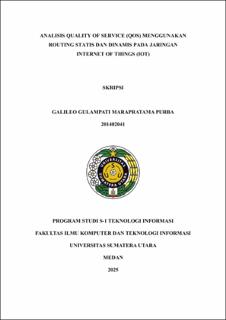Analisis Quality of Service (QOS) Menggunakan Routing Statis dan Dinamis pada Jaringan Internet of Things (IoT)
Quality of Service (QOS) Analysis Using Static and Dynamic Routing on Internet of Things (IoT) Networks

Date
2025Author
Purba, Galileo Gulampati Marapratama
Advisor(s)
Zendrato, Niskarto
Seniman
Metadata
Show full item recordAbstract
Internet of Things (IoT) is one of the growing subjects of technology today. IoT has been used in various ways such as for the industrial field, medical field, smart home development, collection and support of observations and field data retrieval, even to vehicles such as autonomous cars or drones. With the increasing number of IoT devices and their utilization in Indonesia. So, the existing IoT devices must be ensured to work as optimally as possible. One of the efforts to optimize the work of IoT devices is to use a good network routing protocol. By using a good routing protocol on the IoT device. Then, the data transfer between IoT devices have increased quality so that the entire IoT system can run at its finest. To determine the best routing protocol for IoT devices, routing protocol analysis can be done based on Quality of Service (QoS) parameters, which is throughput, packet loss, delay, latency, and jitter parameters. The routing protocols tested for this research are static routing protocol, dynamic routing named Routing Information Protocol (RIP), and dynamic routing named Open Shortest Path First (OSPF). The number of IoT devices used is 45 virtual node devices based on aarch64 architecture and 5 physical node devices based on esp32 architecture. The results show that the static routing protocol has the largest throughput value and is very good at handling network delay and jitter, RIP dynamic routing protocol has the lowest latency values, and OSPF dynamic routing protocol has the best ability to handle packet loss on IoT networks.
Collections
- Undergraduate Theses [873]
